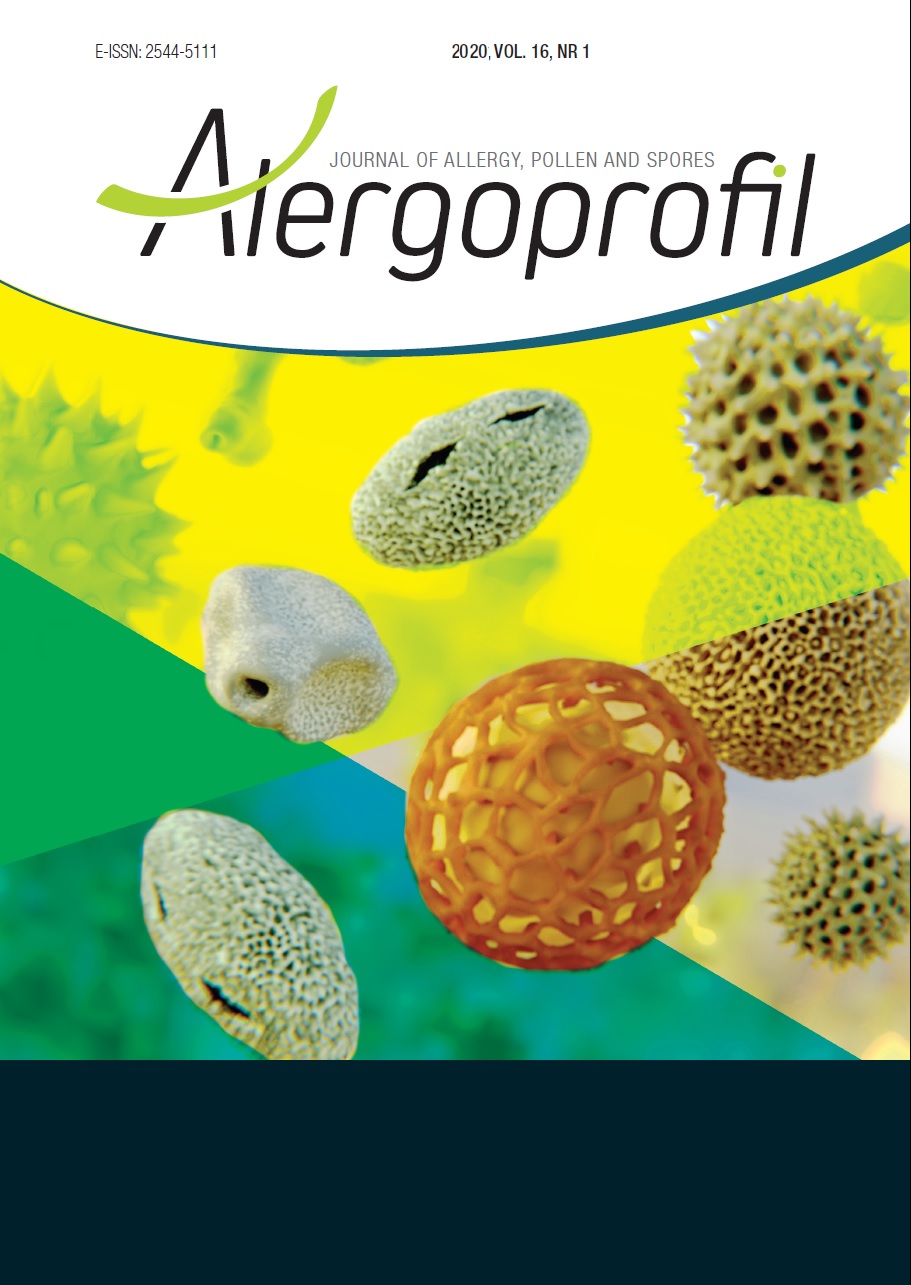Plane tree pollen season in Poland and Hungary in 2019 – why are the plane trees planted in cities so much? Artykuł oryginalny
##plugins.themes.bootstrap3.article.main##
Abstrakt
Allergic diseases are considered as important human health issues as they substantially restrict many allergic people. Trees such as the plane tree can pose a certain threat to allergy sufferers. Due to the frequent planting of these trees in large cities, their pollen can affect the increase in the frequency of local allergy symptoms. This study compares the plane tree pollen seasons in Poland, in Bialystok, Bydgoszcz, Warsaw, Zielona Gora, Piotrkow Trybunalski, Opole, Olsztyn, Szczecin and in Hungary, in Budapest, Debrecen, Gyor, Kaposvar, Kecskemet, Miskolc, Nyiregyhaza and Pecs in 2019. The investigations were carried out using the volumetric method (Hirst type pollen sampler). Seasonal Pollen Index (SPI) was estimated as the sum of daily average pollen concentrations in the given season. The season ranges from March to May, depending on the geographical latitude. Diagnosis of plane tree pollen allergy is made difficult due to some cross-reactivity with birch, but also alder, hazel, hornbeam, oak, beech, sweet chestnut, and to some extent with grass pollen. In 2019 the pollen season of Platanus started first in Hungary, in Pecs on the April 1st; in Poland the pollen season started in Szczecin and Zielona Gora on the April 4th. At the latest, a pollen season ended in Poland, in Warsaw and Bydgoszcz until May 11th–12th, similarly in Hungary – until May 11th in Budapest and Kaposvar. The differences of pollen seasons duration were very considerable, from 15 to 40 days. Also the differences of the highest airborne concentration especially between both countries were extremely considerable (2105 pollen grains/m3 in Nyíregyháza and 3 pollen grains/m3 in Białystok. The maximum values of seasonal pollen count in Polish cities occurred between April 24th and May 1st, and in Hungarian cities between April 9th and 16th. The highest plane tree pollen allergen hazard occurred in 2019 undoubtedly in Hungary: in Pecs, Kaposvar and Nyiregyhaza, and was ten times higher than in Poland. The highest variability in the analysed seasons was found in the peak value and annual total.
Pobrania
##plugins.themes.bootstrap3.article.details##
Copyright: © Medical Education sp. z o.o. This is an Open Access article distributed under the terms of the Attribution-NonCommercial 4.0 International (CC BY-NC 4.0). License (https://creativecommons.org/licenses/by-nc/4.0/), allowing third parties to copy and redistribute the material in any medium or format and to remix, transform, and build upon the material, provided the original work is properly cited and states its license.
Address reprint requests to: Medical Education, Marcin Kuźma (marcin.kuzma@mededu.pl)
Bibliografia
2. Sunset Western Garden Book. 1995; 606-7.
3. APG III. An update of The Angiosperm Phylogeny Group classification for the orders and families of flowering plants: APG III. Bot J Linn Soc. 2009; 161(2): 105-21. https://doi.org/10.1111/j.1095-8339.2009.00996.x.
4. Hofman T, Michalik J. Alergia pyłkowa. Centrum Alergologii, Poznań 1998.
5. Rodriguez-Rajo FJ, Iglesias I, Jato V. Allergenic airbornepollen monitoring of Vigo (NW Spain) in 1995–2001. Grana 2004; 43: 164-73.
6. Burge HA. Monitoring for airborne allergens. Ann Allergy. 1992; 69: 9-21.
7. Mandrioli P, Comtois P, Dominguez E et al. Sampling: Principles and Techniques. In: Mandrioli P, Comtois P, Levizzani V (ed). Methods in Aerobiology. Pitagora Editrice Bologna, Bologna 1998; 47-112.
8. Emberlin J, Savage M, Woodman R. Annual variations in the concentrations of Betula pollen in the London area 1961–1990. Grana 1993; 32: 359-63. https://doi.org/10.1080/00173139309428965.
9. Jochner-Oette S, Stitz T, Jetschni J et al. The Influence of Individual- Specific Plant Parameters and Species Composition on the Allergenic Potential of Urban Green Spaces. Forests 2018; 9: 284. https://doi.org/10.3390/f9060284.
10. Łukasiewicz S. Drzewa i krzewy polecane do obsadzeń ulicznych w miastach. Monografia pod red. Moniki Drozdek. Rośliny do zadań specjalnych. PWSZ, Sulechów 2010; 328.
11. Norris-Hill J, Emberlin J. Diurnal variation of pollen concentration in the air of north-central London. Grana 1991; 30: 229-34.
12. Puc M. Pyłek platanu w powietrzu Szczecina (2009–2010). Alergoprofil. 2010; 6(3): 31-2.
13. Puc M, Rapiejko P, Lipiec A et al. Pyłek platanu w powietrzu wybranych miast Polski w 2014 r. Alergoprofil. 2014; 10(3): 54-7.
14. Mimet A, Pellissier V, Quenol H. et al. Urbanisation induces early flowering: evidence from Platanus acerifolia and Prunus cerasus. Int J Biometeorol. 2009; 53: 287-98.

